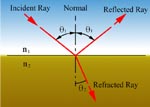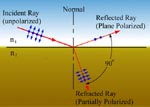|
Optical
Coating
Whenever light passes from one medium into another medium
with different optical properties, most notably refractive
index, part of the light is reflected and part of the
light is transmitted. The intensity ratio of the reflected
and refracted components is a function mainly of the difference
in refractive index among the materials, the polarization
of the incident light and the angle incidence.
According
to Fresnel's law, it is convenient
to think of incident radiation as the superposition of
two plane-polarized beams, p-polarized which electric
field paralled to plane of incidence and s-polarized which
electric field perpendicular to the plane of incidence.
Frenel laws can be summarized
the following two equation:

When
reflected and refracted rays are perpendicular to each
othere(q1+q2=
90), the reflected light is completely s-polarized. This
angle is called Brewster angle.
Optical
coatings are used to alter the reflectance, transmittance,
absorbance, or polarizer properties of optical components.
The optics being coated is usually called the substrate.
The coating is deposited in high vacuum using the process
of evaporation by either e-beam, resistive heat or IAD(Ion
Assisted Deposition) in conjunction with an e-beam source.
We can also offer coating done with an APS( Advanced Plasma
Source) by Leybold. This technique combines the advantages
of IAD coatings and ion plating without some of the drawbacks
associated with ion plating. We can offer state-of-the-art
equipment, advanced design software and highly experienced
engineers to provide you with absolutely the highest level
of support. Coating material include metal (Au, Al, Ag,
Ni-Cr, Cr and so on), dieletrics(Oxides, Fluorides and
Sulfides) and semiconductors(Si, Ge).
Optical
interference coatings respond differently to s and p polarized
light. For this reason, it is essential to specify s,
p, or random (the average of the s and p performance)
polarization when the angle of incidence exceeds 20 degrees.
|
|

 |